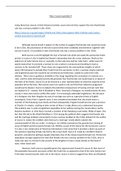Mary I source question 4
Using these four sources in their historical context, assess how far they support the view that female
rule was a serious problem in the 1550s.
https://www.ocr.org.uk/Images/170318-unit-h505-y106-england-1485-1558-the-early-tudors-
sample-assessment-materials.pdf
Although sources B and C appear on the surface to suggest that female rule caused no issues
in the 1550s, the provenance of the two sources limits their credibility and therefore, together with
sources A and D, it is possible to infer that female rule was a serious problem in the 1550s.
Both sources A and D highlight the fear of female rule which pervaded the patriarchal Tudor
period. In source A, this is implied by Edward’s declaration that the crown shall pass ‘firstly to the
eldest son of Lady Frances Frey or, secondly, to the Lady Jane and her male heirs’, while source D
openly states that ‘to promote a woman to rule a nation is unnatural and insulting to God as
contrary to his revealed will’. These views are supported by the extraordinary lengths to which
Henry VIII had gone to exclude Mary Tudor from the succession; to him, a woman simply could not
rule England because she would be too emotional and indecisive, unable to control her male
advisors. There was no guidance available to the clergy regarding the coronation of a woman as a
ruler, and the male-dominated society did genuinely fear that female rule would lead to a repeat of
the Wars of the Roses. Source D can be viewed as a clear representation of what the majority of the
populace felt at the time: that women were too weak to rule and that their indecisive judgement
would lead to disaster. Source A explains the potential consequences of having a female ruler that
are implied in D – namely, that if Elizabeth or Mary ‘(married) a foreigner, he would practise his own
country’s laws and customs within this realm’. To increasingly nationalist Englishmen, the intrusion
of a foreigner into their kingdom by way of marriage was seen as a genuine threat to English
sovereignty. Given Mary’s Spanish roots, it was considered inevitable that she would marry a
member of the Habsburg royal family and that subsequently, England would become just a province
of Charles V’s empire. Looking at later events of Mary I’s reign allows us to understand how great
this problem was. In spite of significant opposition to her policies among the conservatives, led by
Stephen Gardiner, in 1554 Mary married a member of the Habsburg royal family, Philip of Spain. The
fact that this led to the Wyatt Rebellion in 1554 among the political elites suggests that female rule
and the marriage problem connected to it was a serious problem in the 1550s. Edward VI, the author
of source A, makes the credible claim that such a marriage ‘would utterly subvert the
commonwealth of this our realm’. In doing so, he reliably summarises the genuine fear among all
areas of English society towards female rule. Written as part of the Devise for the Succession, source
A is also a very useful piece of historical information in the sense that it provides a direct account of
the opinions regarding female rule felt by the crown itself. Source D, made by a Scottish Calvinist
preacher, provides the perhaps equally important view of the clergy towards female rule. His fervent
opposition strongly supports the view that female rule was a serious problem in the 1550s, since it
really was seen as a threat to the security of the kingdom to have a lowly female at the head of
state, when faced with
However, both sources arguably ignore the argument put forward in source B: that most of
the population favoured succession within the Tudor line as opposed to that of the Grey family even
if the latter leaned towards male rule in the future. Source A tries to suggest that Mary and Elizabeth





